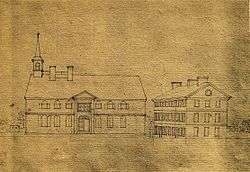The Academy and College of Philadelphia

The Academy and College of Philadelphia in Philadelphia, Pennsylvania, United States was a secondary school and later University located in Philadelphia. It was founded in 1749 by a group of local notables that included Benjamin Franklin and initially included a "charity school" that taught reading, writing, and arithmetic and a secondary school, the Academy, offering a more advanced curriculum.
History
Franklin, the first president of the board of trustee drew up the constitution for the academy, which was notable for its emphasis on modern languages and science in place of Latin and Greek. The academy opened for the secondary schooling of boys on August 13, 1751 with a charity school opening shortly afterwards.
The building that housed the academy had originally been set up in 1740 as a charity school supporting the ministry of George Whitefield with a hall for him to preach in, although Franklin who had a hand in it made sure its use was wider:
- Both house and ground were vested in trustees, expressly for the use of any preacher of any religious persuasion who might desire to say something to the people at Philadelphia; the design in building not being to accommodate any particular sect, but the inhabitants in general; so that even if the Mufti of Constantinople were to send a missionary to preach Mohammedanism to us, he would find a pulpit at his service.[1]
The College was granted a charter in 1755 and graduated its first class of seven men on May 17, 1757, at its first commencement; six graduated with Bachelor of Arts degrees and one with a Master of Arts. William Smith became the Provost in 1756.
In 1765, John Morgan and William Shippen, Jr. founded the Medical School of the College of Philadelphia, the first medical school in North America. That same year the first dormitory was built.
The college educated many of the future leaders of the United States. Twenty-one members of the Continental Congress were graduates of the school, and nine signers of the Declaration of Independence were either alumni or trustees of the university.[2]
The trustees at the time of the American Revolution were seen as Loyalist sympathisers and when the revolutionary government of Pennsylvania regained control of the city of Philadelphia after the British occupation of 1777-8, it rechartered the institution as the "University of the State of Pennsylvania," appointed new trustees, and dismissed William Smith as Provost. Following repeated lawsuits by Smith and the original trustees, the state restored the College's charter in 1789, but the University continued to operate on the original campus. The two competing institutions merged in 1791, forming the University of Pennsylvania.
References
- ↑ Franklin, Benjamin (2006) [1791]. Autobiography of Benjamin Franklin. p. 80. Retrieved Apr 30, 2016.
- ↑ The Early Years: The Charity School, Academy and College of Philadelphia at the University of Pennsylvania Archives, 1972.
External links
http://www.archives.upenn.edu/histy/features/1700s/penn1700s.html